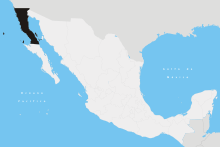Costa Azul LNG
| Costa Azul LNG | |
|---|---|
| Location | |
| Country | Mexico |
| Location | Near Ensenada, Baja California, Mexico |
| Coordinates | 31°58′55″N 116°50′10″W / 31.982°N 116.836°W |
| Details | |
| Opened | 2008 |
| Land area | 100 acres (0.40 km2) |
| Available berths | 1 up to Q Max |
| Statistics | |
| Annual cargo tonnage | Up to 7.6 million tons a year. |
|
Website http://www.energiacostaazul.com.mx http://www.sempralng.com | |
Costa Azul LNG is sea port and natural gas processing center, located 15 miles north of Ensenada, Baja California, Mexico. Opened in 2008, the terminal can process, regasification, up to one billion cubic feet of natural gas per day. This is the first liquefied natural gas (LNG) terminal on the North America west coast. LNG carrier ships capable of holding up to 220,000m3 of LNG can dock in the deep water port off the coast to unload LNG. The natural gas from the terminal is used to produce electricity and is fed by pipe lines to factories. The longest pipeline runs north, to the United States. Sempra Energy is a partner in the port with PEMEX. The LNG ship Al Safliya was the first ship to port and unload at Costa Azul. The Al Safliya is a 210,000 cubic meter LNG ship, its LNG was from Qatar.[1][2] The other Mexican LNG Terminal in the Pacific Ocean is at Manzanillo, Colima, the Manzanillo LNG Terminal.

Details
Contract to build the port was made in 2004. The port as a man made breakwater jetty. The port has two full-containment storage tanks each holding 160,000 cubic meters. The port can receive from ships 1,000,000,000 cubic feet (1 bcf) a day. The port was built by: Techint SA de CV of Mexico, Black & Veatch of Overland Park, KS, Mitsubishi Heavy Industries of Tokyo, Vinci Construction Grands Projects of France and Freyssinet: LNG Tank post-tensioning.[3] A man made 625 meter breakwater was built to project ships docked off shore. To minimize the ecological impact, some sea life was relocated and a plant nursery was built on site.[4] The port has one berth that can handle up to a Q-Max ship. A Q-Max is the largest LNG ship that can hold up to 266,000 sq/m or 6.9 Bcf of natural gas.
Usage
Costa Azul LNG terminal is not used at the full capacity of 1 Bcf/d. Shipments of LNG from the Middle East and Indonesia have gone to Asia as demand and prices are higher there. Also import demand is lower now, as the Kern River Pipeline and Ruby Pipeline are now feeding the Western and Southwestern United States.[5]
See also
| Wikimedia Commons has media related to LNG carriers. |
References
- ↑ prnewswire.com, PEMEX, Sempra LNG And IEnova Sign Memorandum Of Understanding For Developing Natural Gas Liquefaction Facilities In Mexico
- ↑ Costa Azul LNG Import Facility
- ↑ Costa Azul LNG Terminal
- ↑ energy.ca.gov, Costa Azul, Bill Kekker, July 2006
- ↑ U.S. Securities and Exchange Commission, Mexico Week: Record Mexican natural gas imports include higher flows from U.S., May 2013
